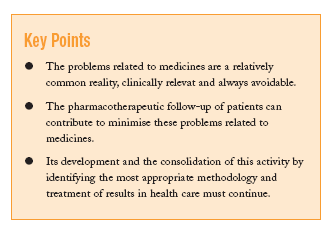Medication is, in all probability, the most used therapeutic tool, therefore its proper use and the effects derived from it are highly relevant from the perspective of obtaining results in health and the quality of the health services provided. However, the available data shows there are margins for improvement in pharmacological treatment. Thus, the average percentage of avoidable hospital admissions arising from morbility associated with medication is 4.3%,1 and among people older than 65 years the percentage of adverse reactions to medications, which could be considered preventable, exceeds 25%.2 This situation, with its relevance to health as well as its susceptibility to improvement, seems to call for an appropriate response from the health authorities and from its professionals.
Pharmaceutical care, carried out by pharmacists in collaboration with other health professionals and the patient, is a group of interventions aimed at reducing the possible problems arising from medication. Pharmacotherapeutic follow-up is included within the framework of pharmaceutical care activities, which is defined as the professional practice in which the pharmacist is responsible for the needs of the patient as regards medications by continuously, detecting, preventing and resolving problems related to these medications (PRM), using systematic and documented methods, in collaboration with the patient him/herself and the rest of the health service professionals, with the aim of achieving concrete results which may improve the quality of life of the patient.3
Pharmacotherapeutic patient follow-up has been in the process of development since the 1990's, with the publication of different studies which report the interventions and methods employed, as well as the results obtained.
The article entitled "Pharmacotherapeutic Follow-up of Patients by Community Pharmacists" is a new addition which contributes to the spreading of the knowledge of these activities to other health professionals and reinforces their value as useful interventions to reduce the number of PRM. The authors obtained a satisfactory level of effectiveness for the interventions, resolving almost 78% of the problems detected. The fact that 28% of the resolved problems corresponded to adverse reactions to the drugs is notable, and another 28% related to problems derived from a lack of efficacy due to therapeutic non-compliance by the patient.
Different studies show that the morbility associated with the adverse effects of drugs is a real health problem. Thus, a rate of adverse reactions of 50.1 per 1000 population per year2 was found in non-hospitalised elderly patients, and as has been mentioned, the average percentage of avoidable hospital admissions generated by these adverse reactions stands at 4.3%. The health and economic repercussions arising from this problem are, therefore, relevant and evident. On the other hand, therapeutic non-compliance is relatively frequent; it is estimated that it occurs in 30 to 50% of elderly patients, a percentage which could increase to 70%4,5 in some illnesses. This non-compliance generates, on the one hand, a health risk to the patient, as we are faced with an incorrectly treated health problem, and on the other hand, it is often seen, falsely, as therapeutic failure which provokes unnecessary changes to treatments with other drugs, perhaps less adequate than the first ones. In this scenario, the results obtained by the authors of the study have been positively evaluated which, as they say, appear to minimise these 2 widely prevailing and highly relevant clinical problems.
Likewise, the fact that 75% of the PRM were resolved with the participation of the doctor, is interesting, inasmuch as it involves working as a team and shows multidisciplinary collaboration.
All the published works which evaluate pharmaceutical care activities agree in the results obtained in regard to the resolving of PRM. However, there are a smaller number of studies which evaluated the benefit of these interventions in terms of quality of life or improvement in health, and their conclusions are not unanimous.
It seems obvious that fewer adverse reactions to drugs, interactions between them, or an improvement in the rate of therapeutic compliance should help us to obtain real benefits in terms of health. The lack of agreement in the results in some studies demands new ones, which should be directed at clarifying the health benefits for the patients to whom these problems refer. On the other hand, the fact that the methods used in the interventions of the different published works have also been different, opens up the possibility that the differences found may be related to the method used in performing the pharmaceutical care activities, which should justify another line of investigation. Likewise, it worth thinking about the efficacy of implementing these activities in the closed and open institutions of the National Health System, which could be developed by the pharmacists of the pharmaceutical services in hospitals and primary care centres.
In conclusion, the results of this study are consistent with those obtained in other published studies and contribute to the development of a promising and encouraging field which can benefit, in the first place, the patients, but also the other professionals and lastly, the health services themselves. However, it is necessary to proceed to confirm the benefits in health of these activities, as well as identifying the most appropriate work methods.









